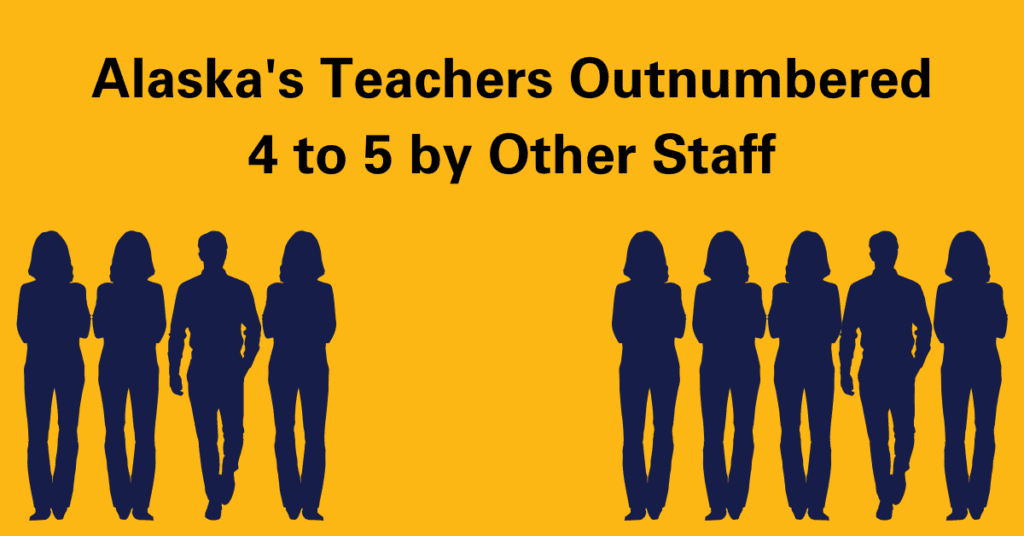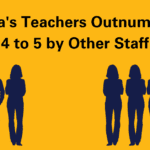 Alaska’s teachers are outnumbered by other staff in all but seven school districts. For every four teachers in Alaska, there are five staff members performing functions peripheral to the business of teaching Alaska’s students.
Alaska’s teachers are outnumbered by other staff in all but seven school districts. For every four teachers in Alaska, there are five staff members performing functions peripheral to the business of teaching Alaska’s students.
To improve Alaska’s dismal education outcomes, funding should be used to directly support students in the classroom. Yet education spending has been increasingly funneled into administrative and support roles, rather than investments in teachers and resources to improve the quality of education for students. Between 2002 and 2020, total education expenditures in Alaska rose by almost a third after adjusting for inflation. Teachers got a meager share of that increase: instructional salaries increased only one percent per pupil, but school and general administrator salaries increased by 42 percent and 18 percent respectively.
Looking at a snapshot of district staffing in the 2021-2022 school year reveals Alaska’s priorities. Data from the National Center for Education Statistics (NCES) District Search tool provides the number of classroom teachers, other staff, and the total number of employees in each of Alaska’s school districts, among other financial data. Staffing data is current as of the 2021-2022 school year and fiscal data as of the 2018-2019 school year. Other staff includes all positions that aren’t teachers, such as district administration, principals, guidance counselors, instructional aides, librarians, and more.
The research shows that investing in high-quality teachers is one of the most important predictors of student success. While school and district leaders may matter in creating a school climate conducive to learning, most administrative staff are not as critical to forming the basic literacy and numeracy skills students needed to meet their full potential. A large number of teachers in a district compared to the number of other staff suggests that the district is investing more in teaching and resources that directly affect students. Conversely, a small number of teachers compared to other staff suggests the district is focusing too much on functions peripheral to teaching basic skills.
On average, each district’s ratio of teachers to other staff is 0.75 — or three teachers for every four members of other staff. Dividing all the teachers statewide by all other staff statewide shows there are four teachers for every five members of other staff.
Of Alaska’s several major school districts, the Mat-Su Borough School District reported the highest ratio of teachers to other staff of nearly one to one (0.96). Teachers were 49% of MSBSD’s staff and expenditures were $15,939 per student, including state, local, and federal funds.
Anchorage School District reported a teacher-to-other-staff ratio of nearly the same (0.95). Teachers comprised almost 49% of all staff. ASD’s total expenditures per student were $16,525, including state, local, and federal funds. The Fairbanks North Star Borough School District reported slightly more than three teachers for every four members of other staff (0.76). Teachers are 43% of the district’s staff and expenditure totals per student were $18,103. See the table in the appendix for the ratios of all districts.
The district with the lowest ratio of teachers to other staff is the Tanana City School District (0.35), which means that for each of the district’s teachers, there are almost three other staff members. Only 26% of the district’s total staff are teachers.
The district with the highest ratio of teachers to other staff is the Aleutian Region School District (1.63). For the district’s four teachers, there are only two full-time staff members and one part-time staff member, as counted by full-time equivalent hours. 62% of the district’s total staff are teachers.
Only seven of Alaska’s 53 school districts reported teachers comprising 50% or more of the district’s total staff. Those districts are Alaska Gateway (69%), Aleutian Region (62%), Craig City (51%), Kenai Peninsula Borough (52%), Nome Public Schools (55%), Sitka (54%), and Yakutat (50%). Mt. Edgecumbe High School also reported 51% of its staff are teachers.
While this data only shows a snapshot in time — the 2021-2022 school year — data back to 2000 shows that the ratio of teachers to other staff has decreased statewide, from nearly one teacher to each member of other staff to the current ratio of four teachers to five members of other staff.
While some of the functions performed by other staff are surely worthwhile, they remain peripheral to teaching Alaska’s students the basic skills needed to succeed. Districts should prioritize teachers and students in the classroom, not administrative bloat.
Table: Ratios of teachers to other staff by district in the 2021-2022 school year. Alaska’s five major school districts are highlighted in gold.

